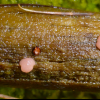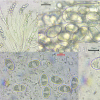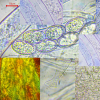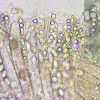
19-11-2025 13:04
 Bruno Coué
Bruno Coué
Bonjour,je sollicite votre avis pour la récote

17-11-2025 21:46
Philippe PELLICIERBonjour,Récolté sur bois pourrissant de feuillu

16-11-2025 21:09
 Robin Isaksson
Robin Isaksson
Anyone recognize this acc. to pictures.? Found on

18-11-2025 13:59
Nogueira HéctorNovember 14, 2025 Brazuelo (León) SPAIN Hymenosc

17-11-2025 19:14
herman lambertApothécie discoïde 0.6 cm diam., orangeFace hym�

17-11-2025 21:57
Philippe PELLICIERBonjour,Récolté sur bois de feuillu mort dur, no

14-11-2025 16:26
 Marian Jagers
Marian Jagers
Hello everyone, On dead wood of Cytisus scoparius

15-11-2025 23:22
Mario FilippaHello,this is what I think to be Hymenoscyphus mac

15-11-2025 20:25
 Riet van Oosten
Riet van Oosten
Hello, Found by Laurens van der Linde, Nov. 2025
Iodophanus hyperboreus?
Lothar Krieglsteiner,
02-08-2024 10:07
 .. found in the French Alps, 5.7.24, 1455 m NN, two quite large apothecia (about 2-3 mm) with beautiful rosy-pink tint growing on a very strongly decayed and water-soaked piece of wood lying in a fountain situation between mosses like Cratoneuron commutatum and Philonotis fontana, wet situation (in the surrounding nearly every habitat was fully dried out). The nitrogen-level was low which is indicated already by the mosses, and by spermatophytes (e.g. Parnassia palustris, Pinguicula vulgaris not far away).
.. found in the French Alps, 5.7.24, 1455 m NN, two quite large apothecia (about 2-3 mm) with beautiful rosy-pink tint growing on a very strongly decayed and water-soaked piece of wood lying in a fountain situation between mosses like Cratoneuron commutatum and Philonotis fontana, wet situation (in the surrounding nearly every habitat was fully dried out). The nitrogen-level was low which is indicated already by the mosses, and by spermatophytes (e.g. Parnassia palustris, Pinguicula vulgaris not far away).The sea level is perhaps a bit low, but I think I. hyperboreus should be a better choice than I. testaceus. I measured the spores with about 19-21/11,5-13 µm. My cotton blue stain was not very good working, maybe because of the very wet water-soaked material. The spores were finely warty . The paraphyses are perhaps distinctive, too - they are swollen and strongly guttulate.
Can I. hyperboreus be confirmed or am I fully on a wrong road?
Best regards, Lothar
Nicolas VAN VOOREN,
02-08-2024 15:45

Re : Iodophanus hyperboreus?
Why not simply I. carneus? It usually grows on dungs, but on a decaying substrate it might be possible...
To my knowledge, I. hyperboreus is terrestrial and has smaller ascospores.
To my knowledge, I. hyperboreus is terrestrial and has smaller ascospores.
Lothar Krieglsteiner,
02-08-2024 15:55

Re : Iodophanus hyperboreus?
Hello Nicolas,
thanks for your opinion.
But ....
Medardi & al. 2006 for his new species hyperboreus: Sp 18-23/10-12 µm
In his key he gives for I. carneus measures of 17-19/10-11,5 and for I. testaceus 17,5-22,5/10,5-14,5
In Prokhorov 1997 I find for I. carneus 15-20/10-12, and for I. testaceus 18-22,5/12-13,5
My measures were (I repeat): 19-21/11,5-13
.
Wood (stronly decayed) or not wood is in my eyes less important than the nitrogen situation (carenus and testaceus are known as strong nitrophytes, and so I always found them before), I. hyperboreus grows at wet (and cold - ... yes) that are nitrogen-poor. I think the ecology is more like my find than that of carneus/testaceus.
Best regards, Lothar
thanks for your opinion.
But ....
Medardi & al. 2006 for his new species hyperboreus: Sp 18-23/10-12 µm
In his key he gives for I. carneus measures of 17-19/10-11,5 and for I. testaceus 17,5-22,5/10,5-14,5
In Prokhorov 1997 I find for I. carneus 15-20/10-12, and for I. testaceus 18-22,5/12-13,5
My measures were (I repeat): 19-21/11,5-13
.
Wood (stronly decayed) or not wood is in my eyes less important than the nitrogen situation (carenus and testaceus are known as strong nitrophytes, and so I always found them before), I. hyperboreus grows at wet (and cold - ... yes) that are nitrogen-poor. I think the ecology is more like my find than that of carneus/testaceus.
Best regards, Lothar




